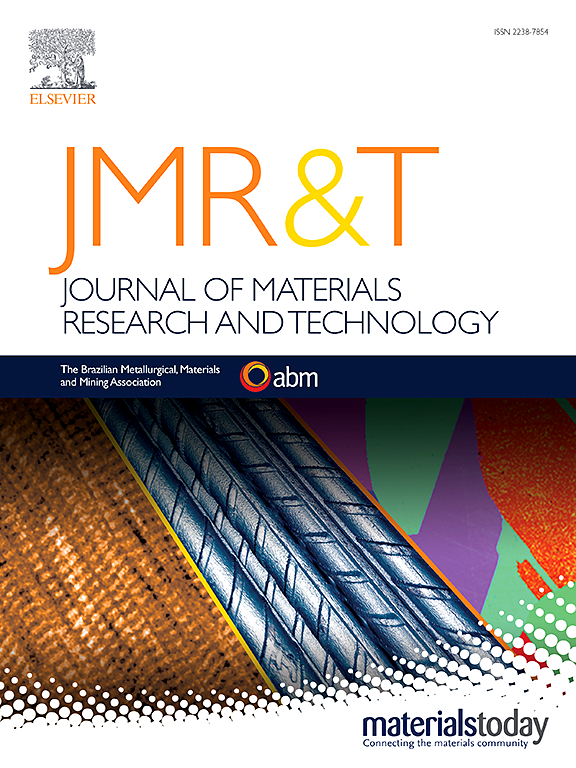In-situ aluminum 7075 metal matrix composites development for additive friction stir deposition
IF 6.2
2区 材料科学
Q1 MATERIALS SCIENCE, MULTIDISCIPLINARY
Journal of Materials Research and Technology-Jmr&t
Pub Date : 2025-06-04
DOI:10.1016/j.jmrt.2025.05.258
引用次数: 0
Abstract
Al7075 equivalent aluminum + Al2O3 metal matrix composite (G7D) feedstock tailored for Additive Friction Stir Deposition (AFSD) was successfully produced using the powder metallurgy and hot extrusion process. Two types of feedstocks with different densities, categorized as High Porosity (HP) and Low Porosity (LP) rods, were AFSD deposited to evaluate their performances. High-quality and fully dense AFSD samples were successfully deposited using both HP and LP rods. The microstructure, grain size distribution, and hardness were evaluated in the as-deposited AFSD samples. The deposited G7D exhibited complex material flow, but deposition parameters had minimal impacts on the flow patterns. During the AFSD process, ceramic particles (Al2O3) were evenly dispersed in the matrix. The use of elemental powders rather than pre-alloyed powders allows the low-melting-point metal Zn in the powder mix to form a liquid-phase diffusion pathway during hot extrusion/AFSD, improving the wettability of Al2O3 particle surfaces and significantly strengthening the connection between the aluminum matrix and the Al2O3 particles. It shows the significant potential of AFSD in fabricating Aluminum Metal Matrix Composites (AMMC) for producing high-quality AMMC components with comparable or superior performance to those made by conventional methods.
添加剂搅拌摩擦沉积原位铝7075金属基复合材料的研制
采用粉末冶金和热挤压工艺成功制备了适用于添加剂搅拌摩擦沉积(AFSD)的Al7075等效铝+ Al2O3金属基复合材料(G7D)。将两种不同密度的原料分为高孔隙率(HP)棒和低孔隙率(LP)棒,进行AFSD沉积以评估其性能。使用高压和低压棒成功沉积了高质量和全致密的AFSD样品。对沉积态AFSD试样的显微组织、晶粒尺寸分布和硬度进行了评价。沉积的G7D表现出复杂的物质流动,但沉积参数对流动模式的影响很小。在AFSD过程中,陶瓷颗粒(Al2O3)均匀地分散在基体中。使用单质粉末而不是预合金粉末,可以使粉末混合物中的低熔点金属Zn在热挤压/AFSD过程中形成液相扩散通道,提高Al2O3颗粒表面的润湿性,并显著加强铝基体与Al2O3颗粒之间的连接。这表明了AFSD在制造铝金属基复合材料(AMMC)方面的巨大潜力,可以生产出性能与传统方法相当或优于传统方法的高质量AMMC部件。
本文章由计算机程序翻译,如有差异,请以英文原文为准。
求助全文
约1分钟内获得全文
求助全文
来源期刊

Journal of Materials Research and Technology-Jmr&t
Materials Science-Metals and Alloys
CiteScore
8.80
自引率
9.40%
发文量
1877
审稿时长
35 days
期刊介绍:
The Journal of Materials Research and Technology is a publication of ABM - Brazilian Metallurgical, Materials and Mining Association - and publishes four issues per year also with a free version online (www.jmrt.com.br). The journal provides an international medium for the publication of theoretical and experimental studies related to Metallurgy, Materials and Minerals research and technology. Appropriate submissions to the Journal of Materials Research and Technology should include scientific and/or engineering factors which affect processes and products in the Metallurgy, Materials and Mining areas.
 求助内容:
求助内容: 应助结果提醒方式:
应助结果提醒方式:


